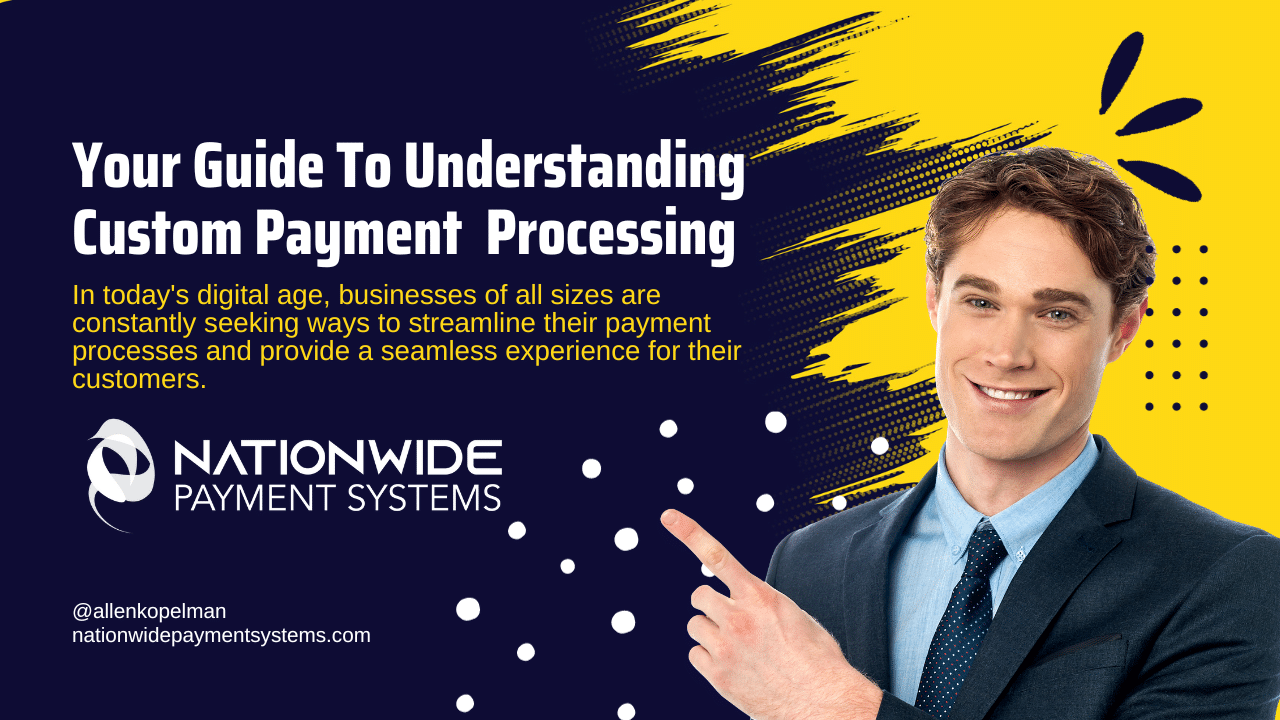Your Guide to Understanding Custom Payment Processing

In today’s digital age, businesses of all sizes are constantly seeking ways to streamline their payment processes and provide a seamless experience for their customers. One way to achieve this is through custom payment processing solutions. Custom payment processing allows businesses to tailor their payment systems to their specific needs, providing a more efficient and personalized experience for both the business and its customers.
In this blog post, we will delve into the world of customized payment processing and explore how it works. We will discuss the role of payment gateways and how they integrate with various business platforms. Additionally, we will explore the transaction flow in custom payment processing, providing a comprehensive understanding of the entire process.
But why should businesses consider implementing custom payment processing? Throughout this post, we will highlight the benefits of this approach. From a seamless user experience to enhanced security measures and customizable features, customized payment processing offers numerous advantages that can significantly improve the payment process for businesses and their customers.
Of course, implementing custom payment processing requires careful consideration and planning. We will guide you through the process, from choosing the right payment processor to integration and setup. We will also discuss the importance of testing and deployment to ensure a smooth transition for your business.
Once your customized payment processing system is up and running, it is essential to maintain and upgrade it regularly. We will provide insights into how to conduct regular system checks, handle updates and upgrades, and troubleshoot common issues that may arise.
In conclusion, custom payment processing is the future of efficient and personalized payment systems for businesses. By understanding how it works, its benefits, and the implementation process, businesses can take their payment processes to the next level. Join us as we dive into the world of custom payment processing and discover how it can revolutionize your business’s payment experience.
Introduction to Custom Payment Processing
Customized payment processing refers to the implementation of a tailored payment system that is specifically designed to meet the unique needs of a business. Unlike traditional payment processing methods, which often provide a one-size-fits-all approach, custom payment processing allows businesses to have more control and flexibility over their payment systems.
In this section, we will explore the concept of custom payment processing in more detail. We will discuss the limitations of standard payment processing methods and highlight the need for a customized solution. Additionally, we will examine the advantages that custom payment processing can offer to businesses, both in terms of user experience and overall efficiency.
The Limitations of Standard Payment Processing Methods
Traditional payment processing methods, such as using third-party payment gateways or relying on basic point-of-sale systems, often come with limitations that may not align with a business’s specific requirements. These limitations can include:
- Lack of customization: Standard payment processing methods may not offer the level of customization needed to match a business’s branding, user interface, or specific functionality requirements.
- Limited integration options: Many businesses operate across multiple platforms or have complex backend systems. Standard payment processing methods may not seamlessly integrate with these platforms, leading to inefficient workflows and data inconsistencies.
- Inflexible transaction flows: Standard payment processing methods often have predefined transaction flows that cannot be easily modified to accommodate unique business processes or customer needs.
The Need for Customized Payment Processing
To overcome the limitations of standard payment processing methods, businesses are turning to customized solutions. Customized allows businesses to create a payment system that is tailored to their specific needs, ensuring a more seamless and efficient payment process.
By implementing custom payment processing, businesses can:
- Enhance brand identity: Customized payment processing solutions allow businesses to incorporate their branding elements, providing a consistent and professional user experience for customers.
- Optimize user experience: With custom payment processing, businesses can design intuitive and user-friendly payment interfaces that align with their customers’ preferences, resulting in a smoother and more enjoyable checkout process.
- Streamline operations: Custom payment processing systems can be integrated with a business’s existing platforms and backend systems, enabling automated workflows and real-time data synchronization. This integration helps eliminate manual data entry, reduces errors, and improves overall operational efficiency.
- Gain flexibility and scalability: Custom payment processing solutions can be designed to accommodate future growth and evolving business needs. Businesses can easily add new features, payment methods, or integrations as their requirements change over time.
In the next sections, we will delve deeper into how customized payment processing works and explore the various components involved in its implementation.
How Custom Payment Processing Works
Custom payment processing involves a series of steps and components that work together to facilitate seamless and secure transactions. In this section, we will explore the key elements of custom payment processing and how they interact to ensure a smooth payment experience for businesses and their customers.
The Role of Payment Gateways
Payment gateways play a crucial role in custom payment processing. They function as the intermediary between the merchant’s website or application and the financial institutions involved in the transaction. Here is an overview of how payment gateway’s function:
- Authorization: When a customer initiates a payment, the payment gateway securely transmits the transaction details to the acquiring bank or payment processor for authorization. This step involves verifying the customer’s payment information, such as credit card details or digital wallet credentials.
- Encryption and Security: Payment gateways utilize encryption protocols to secure sensitive data during transmission, ensuring that the customer’s payment information remains confidential and protected from unauthorized access.
- Transaction Routing: Once the payment is authorized, the payment gateway routes the transaction to the appropriate financial institution for processing. This can include the customer’s issuing bank, the payment processor, or other entities involved in the payment network.
- Response Handling: The payment gateway receives the response from the financial institution, indicating whether the transaction was approved or declined. It then relays this information back to the merchant’s website or application, allowing the customer to proceed with the transaction or prompting them to try an alternative payment method.
Integration with Business Platforms
To implement custom payment processing, businesses need to integrate the payment gateway with their existing platforms, such as e-commerce websites, mobile applications, or point-of-sale systems. The integration process typically involves:
- API Integration: Most payment gateways offer APIs (Application Programming Interfaces) that allow businesses to connect their platforms with the payment gateway. Through APIs, businesses can send transaction data to the payment gateway, receive authorization responses, and retrieve transaction details for reporting purposes.
- Platform Compatibility: Businesses need to ensure that the payment gateway they choose is compatible with their platform or can be easily integrated using available plugins or software development kits (SDKs). This compatibility ensures a seamless and efficient integration process.
- Customization and Branding: Depending on the payment gateway, businesses may have the option to customize the payment interface to align with their branding guidelines. This includes adding company logos, color schemes, and other visual elements to provide a consistent user experience.
Transaction Flow in Custom Payment Processing
In customized payment processing, the transaction flow follows a series of steps to complete the payment process. The typical transaction flow involves the following stages:
- Initiation: The customer initiates the payment by selecting their preferred payment method and providing the necessary payment details, such as credit card information or digital wallet credentials.
- Authorization: The payment gateway securely transmits the transaction details to the acquiring bank or payment processor for authorization. The financial institution verifies the customer’s payment information and determines whether the transaction can be approved.
- Processing: If the transaction is approved, the payment gateway routes the transaction to the appropriate financial institutions involved in the payment network. This includes the customer’s issuing bank, the payment processor, and other intermediaries.
- Settlement: Once the transaction is successfully processed, the funds are transferred from the customer’s account to the merchant’s account. This settlement process may take a few business days, depending on the payment processor and the specific payment method used.
- Confirmation: The payment gateway sends a confirmation message to the merchant, indicating the status of the transaction. This confirmation message can be used to update the order status, generate receipts, or trigger any necessary post-payment actions.
By understanding the role of payment gateways, the integration process, and the transaction flow, businesses can gain a comprehensive understanding of how custom payment processing works. In the next section, we will explore the benefits of implementing custom payment processing for businesses and their customers.
Benefits of Custom Payment Processing
Implementing custom payment processing brings numerous benefits for businesses and their customers. In this section, we will explore these advantages in detail, highlighting how custom payment processing can enhance the overall payment experience and improve business operations.
Seamless User Experience
One of the primary benefits of customized payment processing is the ability to provide a seamless user experience for customers. Here’s how custom payment processing achieves this:
- Branded Payment Interface: Custom payment processing allows businesses to incorporate their branding elements into the payment interface. This creates a consistent and familiar look and feel for customers, reinforcing brand identity and building trust.
- Simplified Checkout Process: With customized payment processing, businesses can design intuitive and user-friendly payment interfaces. This includes optimizing the checkout process by reducing friction points, minimizing form fields, and offering convenient payment options. A streamlined checkout process enhances the overall user experience and reduces cart abandonment rates.
- Mobile-Friendly Experience: As mobile commerce continues to grow; custom payment processing enables businesses to provide a mobile-friendly payment experience. The payment interface can be optimized for various mobile devices, ensuring a smooth and responsive checkout process, regardless of the device used.
Enhanced Security Measures
Custom payment processing prioritizes security, safeguarding both businesses and customers from potential threats. Here are the security benefits of custom payment processing:
- PCI Compliance: Payment Card Industry Data Security Standard (PCI DSS) compliance is a crucial requirement for businesses handling credit card information. Custom payment processing solutions are designed with robust security measures to ensure compliance with PCI DSS standards. This includes encryption, tokenization, and secure data storage practices.
- Fraud Prevention Tools: Custom payment processing systems often offer advanced fraud prevention tools, such as fraud detection algorithms and risk management solutions. These tools help identify and prevent fraudulent transactions, protecting businesses from financial losses and preserving the integrity of the payment process.
- Secure Data Transmission: Custom payment processing utilizes secure encryption protocols to protect sensitive customer data during transmission. This ensures that payment information remains confidential and inaccessible to unauthorized individuals.
Customizable Features for Business Needs
Custom payment processing provides businesses with the flexibility to tailor their payment systems to their specific requirements. Here’s how customization benefits businesses:
- Multiple Payment Options: Custom payment processing solutions allow businesses to offer a wide range of payment options to customers. This can include credit and debit cards, digital wallets, bank transfers, or alternative payment methods. By providing diverse payment options, businesses can cater to varying customer preferences and increase conversion rates.
- Integration with Existing Systems: Customized payment processing can seamlessly integrate with a business’s existing platforms, such as e-commerce websites, mobile applications, or point-of-sale systems. This integration streamlines operations, eliminates manual data entry, and enhances overall efficiency.
- Scalability and Futureproofing: Custom payment processing systems can be designed to scale alongside a growing business. They can accommodate increased transaction volumes, support new payment methods, and integrate with additional platforms or business systems. This scalability ensures that the payment system can adapt to future business needs without significant disruptions.
- The most popular payment options today are: EMV, CHIP CARD, Tap and Go, Apple Pay, Google Pay and other wallets that use NFC (Near Field Communication).
- Pay by link, through email or text and electronic invoicing, customers want to enter the information in themselves as they feel that it is more secure and safer.
- By leveraging the benefits of seamless user experience, enhanced security measures, and customizable features, customized payment processing empowers businesses to optimize their payment processes and deliver an exceptional payment experience for customers. In the next section, we will explore the custom payment processing implementation process
Implementing Custom Payment Processing
Implementing custom payment processing requires careful planning, selection of the right payment processor, and seamless integration with existing business platforms. In this section, we will guide you through the implementation process, providing insights and best practices to ensure a successful deployment of custom payment processing.
Choosing the Right Payment Processor
Selecting the appropriate payment processor is a critical step in implementing customized payment processing. Consider the following factors when choosing a payment processor:
- Features and Functionality: Evaluate the features and capabilities offered by different payment processors. Look for functionalities that align with your business requirements, such as support for multiple payment methods, robust security measures, and integration options.
- Security and Compliance: Ensure that the payment processor is compliant with industry security standards, such as PCI DSS. Verify the encryption methods used, data storage practices, and the availability of fraud prevention tools.
- Pricing and Fees: Understand the pricing structure and fees associated with the payment processor. Consider factors such as transaction fees, monthly fees, setup costs, and any additional fees for specific features or services.
- Reputation and Reliability: Research the reputation and reliability of the payment processor. Read reviews, seek recommendations from other businesses, and assess their history in terms of uptime, customer support, and overall customer satisfaction.
Integration and Setup
Once you have selected a suitable payment processor, the next step is to integrate it with your existing business platforms. Consider the following during the integration and setup process:
- Technical Requirements: Understand the technical requirements for integrating the payment processor with your platforms. This may involve using APIs, SDKs, plugins, or custom development. Ensure that your chosen payment processor provides comprehensive documentation and support for the integration process.
- Development and Testing: Allocate sufficient time and resources for development and testing. Collaborate with your development team to implement the necessary code changes, configure settings, and establish a secure connection with the payment processor. Conduct thorough testing to ensure seamless integration and reliable functionality.
- User Acceptance Testing (UAT): Before going live with your customized payment processing system, conduct user acceptance testing to simulate real-world scenarios. Test various payment methods, transaction types, and user flows to identify any potential issues or areas for improvement.
Testing and Deployment
Once the integration and setup are complete, it is important to thoroughly test the custom payment processing system before deploying it in a live environment. Consider the following during the testing and deployment phase:
- Functional Testing: Test all aspects of the payment system, including transaction processing, error handling, refund capabilities, and reporting functionalities. Verify that the system behaves as expected and delivers accurate results.
- Performance Testing: Assess the performance of the custom payment processing system under various load conditions. Evaluate its ability to handle peak transaction volumes and ensure that response times remain within acceptable limits.
- User Training and Documentation: Provide training to your staff on how to use the custom payment processing system. Develop comprehensive documentation, including user guides and troubleshooting resources, to support users in understanding and utilizing the system effectively.
- Gradual Rollout: Consider a gradual rollout approach when deploying the customized payment processing system. This allows you to monitor the system’s performance, address any issues that arise, and make necessary adjustments before fully adopting it across all platforms.
By carefully selecting the right payment processor, seamlessly integrating it with your platforms, and conducting thorough testing and deployment, you can successfully implement customized payment processing for your business. In the next section, we will discuss the importance of maintaining and upgrading your payment processing system.
Maintaining and Upgrading Your Custom Payment Processing System
Once your custom payment processing system is implemented and operational, it is crucial to maintain and upgrade it regularly to ensure its optimal performance and security. In this section, we will discuss the key aspects of maintaining and upgrading your payment processing system.
Regular System Checks
Performing regular system checks is essential to identify and address any potential issues or vulnerabilities. Consider the following practices for maintaining your custom payment processing system:
- Monitoring and Alerting: Implement monitoring tools that provide real-time alerts for any system anomalies, such as unusual transaction patterns, performance degradation, or security breaches. Regularly review these alerts to promptly address any issues that may arise.
- Log Analysis: Regularly analyze system logs to identify any errors, anomalies, or suspicious activities. Log analysis can help detect potential security breaches or system failures, allowing you to take timely action.
- Security Audits: Conduct periodic security audits to assess the robustness of your payment processing system’s security measures. Engage third-party security experts to perform penetration testing and vulnerability assessments to identify and address any potential vulnerabilities.
- Compliance Updates: Stay up to date with industry standards and compliance requirements, such as PCI DSS. Regularly review and implement necessary updates or changes to ensure ongoing compliance.
Handling Updates and Upgrades
To keep your payment processing system up to date and leverage the latest features and enhancements, consider the following practices:
- Vendor Updates: Stay informed about updates and releases from your payment processor or any other third-party providers involved in your custom payment processing system. Regularly review release notes and update your system accordingly to benefit from bug fixes, security patches, and new features.
- Custom Code Maintenance: If you have customized code as part of your payment processing system, ensure that it remains compatible with the latest updates. Regularly review and update your custom code to align with the evolving requirements and changes in the payment ecosystem.
- Testing and Validation: Before implementing any updates or upgrades, perform thorough testing in a non-production environment. Validate the compatibility of the updates with your custom payment processing system and ensure that there are no unintended consequences or disruptions.
- Backup and Recovery: Maintain regular backups of your payment processing system to safeguard against data loss or system failures during updates or upgrades. Implement a robust backup and recovery strategy to minimize downtime and ensure business continuity.
Troubleshooting Common Issues
Despite regular maintenance and updates, issues may still arise with your custom payment processing system. To effectively troubleshoot and resolve these issues, consider the following practices:
- Incident Response Plan: Develop an incident response plan that outlines the steps to be taken in the event of a system failure, security breach, or other critical issues. This plan should include communication protocols, escalation procedures, and a clear course of action to minimize the impact on your business and customers.
- Technical Support: Maintain a reliable technical support channel for your payment processing system. Ensure that your support team is well-trained and equipped to handle and resolve system-related issues promptly.
- Documentation and Knowledge Base: Maintain an up-to-date documentation repository and knowledge base that includes troubleshooting guides, FAQs, and solutions for common issues. This helps your team quickly address recurring problems and saves time in resolving customer inquiries.
By proactively maintaining and upgrading your payment processing system, you can ensure its continued performance, security, and compliance. Regular system checks, handling updates and upgrades, and effective troubleshooting practices will help you deliver a reliable and efficient payment processing experience for your business and customers.
In the next section, we will conclude our discussion by exploring the future of payment processing and the potential advancements in this field.
Conclusion: The Future of Custom Payment Processing
Custom payment processing has become increasingly important in the digital landscape, offering businesses the ability to tailor their payment systems to their specific needs. In this section, we will reflect on the future of payment processing and explore potential advancements that may shape this field.
As technology continues to evolve, we can expect the following trends and developments in payment processing:
- Advanced Security Measures: As the threat landscape evolves, custom payment processing systems will continue to enhance their security measures. This may include the adoption of advanced authentication methods, such as biometrics or multi-factor authentication, to ensure secure and seamless transactions.
- Omnichannel Payment Experiences: With the rise of omnichannel commerce, payment processing will expand to support seamless payment experiences across various channels. This includes integrating payment systems with social media platforms, voice assistants, smart devices, and emerging technologies.
- Enhanced Data Analytics: Customized payment processing systems will increasingly leverage data analytics to provide deep insights into customer behavior, preferences, and buying patterns. Businesses can use this data to optimize their payment processes, personalize customer experiences, and make data-driven decisions.
- Integration with Emerging Technologies: payment processing will integrate with emerging technologies such as blockchain, cryptocurrencies, and Internet of Things (IoT) devices. This integration will open new possibilities for secure and efficient payment methods, expanding the range of options available to businesses and customers.
- Cross-Border Payment Solutions: With the globalization of business, payment processing will focus on providing seamless cross-border payment solutions. This includes supporting multiple currencies, accommodating international payment regulations, and simplifying the complexities associated with global transactions.
- Continuous Improvement and Innovation: payment processing will continue to evolve as businesses seek to optimize their payment processes and enhance customer experiences. Payment processors will invest in research and development to introduce new features, improve usability, and incorporate emerging technologies.
Custom payment processing offers businesses the flexibility, control, and efficiency needed to create a seamless payment experience. By integrating with existing platforms, prioritizing security, and adapting to future advancements, businesses can harness the full potential of payment processing.
As the payment landscape evolves, payment processing will continue to play a vital role in meeting the unique payment needs of businesses and customers. By staying informed and embracing these advancements, businesses can stay ahead of the curve and deliver exceptional payment experiences that drive growth and customer satisfaction.
We hope this comprehensive guide has provided you with a deep understanding of customized payment processing and its benefits. Implementing a custom payment processing system can be a game-changer for your business, revolutionizing the way you handle payments and enhancing the overall customer experience.








